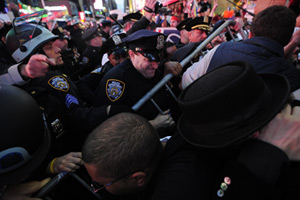US: Just how much can the state restrict protest?
By Braden Goyette in ProPublica
As protests supporting Occupy Wall Street have swelled in recent weeks, hundreds of demonstrators have been arrested across the U.S. This weekend, nearly 100 people were arrested in New York and 175 in Chicago. More than 100 protesters were arrested in Boston last week; a few weeks ago, 700 were arrested on the Brooklyn Bridge.
So, if the First Amendment guarantees the right to peaceable assembly, why do peaceful protestors keep getting arrested — and sometimes pepper-sprayed and beaten up? We take a closer look at the laws governing protests and how the government can limit them. Time, place and manner restrictions The First Amendment is not absolute. Government can make reasonable stipulations about the time, place and manner a peaceable protest can take place, as long as those restrictions are applied in a content-neutral way. But what constitutes a reasonable time, place and manner restriction? “It depends on the context and circumstances,” said Geoffrey Stone, a professor specializing in constitutional law at the University of Chicago. “Things like noise, blockage of ordinary uses of the place, blockage of traffic and destruction of property allow the government to regulate speakers.” Stone gave a few examples of impeding ordinary usage: disturbing patients at a hospital, preventing students from going to school, or, more relevant for the Occupy movement, disrupting the flow of traffic for a long period of time. The majority of Occupy Wall Street-related arrests have been on charges of disorderly conduct. Under the New York Penal Code, that includes making “unreasonable noise,” obstructing “vehicular or pedestrian traffic,” or congregating “with other persons in a public place and refus[ing] to comply with a lawful order of the police to disperse.” Basically, the central question is the standard of reasonableness. “You have to tolerate a certain amount of inconvenience in order to make room for First Amendment activity, but not so much that it disrupts things,” Stone said. Individual states’ unlawful assembly and disorderly conduct statutes have to fall in line with this standard. “They can regulate it less if they want to,” Stone added, “but not more.” Content neutrality Is king Time, place and manner restrictions have to apply to similar types of protests equally, without regard for their message or point of view. Consider this year’s 8-1 Supreme Court ruling that upheld an anti-gay minister’s right to protest at military funerals. He and a few members of his church would picket the funerals of service members killed in Iraq and Afghanistan, asserting that God hates America because of its tolerance for homosexuality. As Stone has explained, under the First Amendment the government can’t ban people from demonstrating because of the homophobic content of what they’re saying at funerals but can set limits on how close to the funeral they can be or how loud they can be. The case of Zuccotti Park All of this applies to public spaces, like sidewalks and parks. But when you get into the territory of private property, it’s a whole different story. “The owner of the private property can lawfully evict [protesters] the same way you can toss someone out of your house if you don’t like them,” Stone said. “When police act at the request of the owner, they’re not doing anything that violates the First Amendment.” Interestingly, this hasn’t happened yet to the Occupy Wall Street demonstrators. A month ago today, they settled on a privately owned park in Lower Manhattan as their base of operations. Brookfield Properties, the park’s owner, sent a letter to the NYPD earlier this week asking for help clearing the space so it could be cleaned. But hours before the scheduled cleaning, Brookfield contacted the city to postpone it. New York Mayor Michael Bloomberg claimed that Brookfield reached its decision under pressure from other elected officials. Update, 10/18: Readers have pointed out that Zucotti Park is a privately owned public space, built by Brookfield in exchange for zoning concessions from the city. As part of the arrangement, the park has to be accessible to the public 24 hours a day; beyond that, the owners can set their own rules about the park’s use. This puts it in a legal gray area. How is the use of force regulated? So, what laws govern how police are allowed to respond to peaceful protesters who overstep the city’s time, place and manner restrictions? Broadly speaking, the unanimous 1989 Supreme Court ruling in Graham vs. Connor set the standard that a reasonable use of force doesn’t violate the Fourth Amendment. Once again, it’s all about “reasonableness,” as defined from the perspective of an officer in the field:
The Fourth Amendment “reasonableness” inquiry is whether the officers’ actions are “objectively reasonable” in light of the facts and circumstances confronting them, without regard to their underlying intent or motivation. The “reasonableness” of a particular use of force must be judged from the perspective of a reasonable officer on the scene, and its calculus must embody an allowance for the fact that police officers are often forced to make split-second decisions about the amount of force necessary in a particular situation.
As The New York Times reported last month, the Manhattan district attorney is investigating an officer’s use of pepper spray on two young women last month. One of the young women who was pepper-sprayed is demanding misdemeanor assault charges be brought against him. According to WNYC radio, the union representing high-ranking officers argues the officer’s actions restored order at that particular protest, and were thus justified.






















